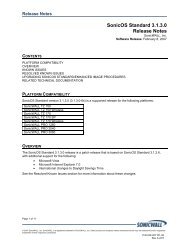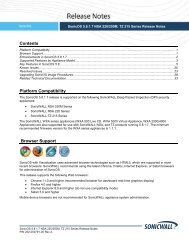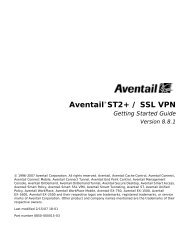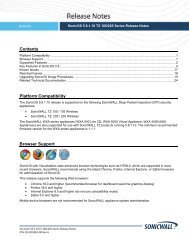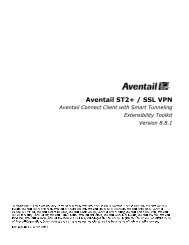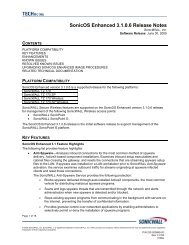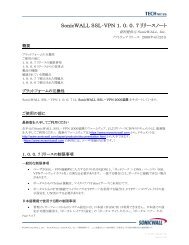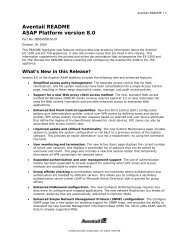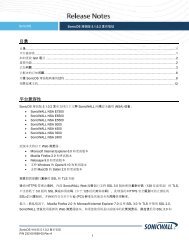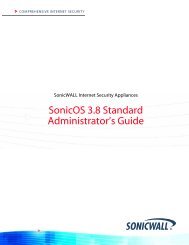SonicWALL Global VPN Client
SonicWALL Global VPN Client
SonicWALL Global VPN Client
- No tags were found...
Create successful ePaper yourself
Turn your PDF publications into a flip-book with our unique Google optimized e-Paper software.
Making <strong>VPN</strong> ConnectionsMaking a <strong>VPN</strong> connection from the <strong>Global</strong> <strong>VPN</strong> <strong>Client</strong> is easy because the configurationinformation is managed by the <strong>SonicWALL</strong> <strong>VPN</strong> gateway. The <strong>SonicWALL</strong> administrator setsthe parameters for what is allowed and not allowed with the <strong>VPN</strong> connection policy. Forexample, for security reasons, the <strong>SonicWALL</strong> <strong>VPN</strong> Gateway administrator may not allowmultiple <strong>VPN</strong> connections or the ability to access the Internet or local network while the <strong>VPN</strong>connection is enabled.The <strong>Global</strong> <strong>VPN</strong> <strong>Client</strong> support two IPSec Keying modes: IKE using Preshared Secret and IKEusing 3rd Party Certificates. Preshared Secret is the most common form of the IPSec Keyingmodes. If your <strong>VPN</strong> connection policy uses 3rd party certificates, you use the CertificateManager to configure the <strong>Global</strong> <strong>VPN</strong> <strong>Client</strong> to use digital certificates.A Pre-Shared Key (also called a Shared Secret) is a predefined field that the two endpoints ofa <strong>VPN</strong> tunnel use to set up an IKE (Internet Key Exchange) Security Association. This field canbe any combination of Alphanumeric characters with a minimum length of 4 characters and amaximum of 128 characters. Your Pre-Shared Key is typically configured as part of your <strong>Global</strong><strong>VPN</strong> <strong>Client</strong> provisioning. If it is not, you are prompted to enter it before you log on to the remotenetwork.Accessing Redundant <strong>VPN</strong> GatewaysThe <strong>Global</strong> <strong>VPN</strong> <strong>Client</strong> supports redundant <strong>VPN</strong> gateways by manually adding the peer in thePeers page of the <strong>VPN</strong> connection Properties dialog box. See “Peers” on page 32 for moreinformation. The <strong>Global</strong> <strong>VPN</strong> <strong>Client</strong> version 2.1.0.0 (or higher) adds automatic support forredundant <strong>VPN</strong> gateways if the IPSec gateway’s domain name resolves to multiple IP address.For example, if gateway.yourcompany.com resolves to 67.115.118.7, 67.115.118.8 and67.115.118.9, the <strong>Global</strong> <strong>VPN</strong> <strong>Client</strong> cycles through these resolved IP addresses until it findsa gateway that responds, allowing multiple IP addresses to be used as failover gateways. If allthe resolved IP addresses fail to respond, <strong>Global</strong> <strong>VPN</strong> <strong>Client</strong> switches to the next peer, ifanother peer is specified in the Peers page of the <strong>VPN</strong> connection Properties dialog box. See“Peers” on page 32 for more information.Page 20 <strong>SonicWALL</strong> <strong>Global</strong> <strong>VPN</strong> <strong>Client</strong> 2.1 Administrator’s Guide



